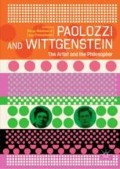Abstract
Eduardo Paolozzi still fascinates today for his art created by drawing upon the visual culture of his time. He mixed not only visuals fragments but also textual material, in order to explore the semantic shifts in the process of appropriation. The chapter focuses on Paolozzi’s animated films as an important body of works to clarify his approach to the poetic space between image, language, and music. On the basis of History of Nothing (1960) and Kakafon Kakkoon (1965) Stallschus analyses the relationship between the screenprints—as source material—and animation. The picture theory of Ludwig Wittgenstein, in particular, the concept of metaphor, became an important point of reference for the artist’s intermedial procedures. Stallschus points out that with his films, Paolozzi provided an artistic interpretation of Wittgenstein’s philosophy, which focuses on the dynamics and the intermediality of the image.
Access this chapter
Tax calculation will be finalised at checkout
Purchases are for personal use only
References
Collins, J. 2014. Eduardo Paolozzi. Farnham: Lund Humphries.
Frank, M. 1989. Wittgensteins Gang in die Dichtung. In Wittgenstein. Literat und Philosoph, ed. F. Soldati, 7–72. Pfullingen: Günther Neske.
Goppelsröder, F. 2010. Bild, Sagen, Zeigen. Wittgenstein visuelles Denken. In Bild und Bildlichkeit in Philosophie, Wissenschaft und Kunst. Image and Imaging in Philosophy, Science, and the Arts, ed. E. Nemeth, R. Heinrich, and W. Pichler. Papers of the 33rd IWS. http://wittgensteinrepository.org/agora–alws/article/view/2883/3490. Accessed 26 June 2017.
Hester, M.B. 1964. An Analysis of the Meaning of Poetic Metaphor. Dissertation, Vanderbilt University Nashville.
Hester, M.B. 1966. Metaphor and Aspect Seeing. The Journal of Aesthetics and Art Criticism 25 (2, Winter): 205–212.
Kemp, M. 1996. Eduardo Paolozzi. In Spellbound: Art and Film, ed. Ian Christie and Philip Dodd, exh.–cat (February 22–May 6), 101–107. London: Hayward Gallery, BFI Publication.
Lüthy, M. 2012. Das Medium der ästhetischen Erfahrung. Wittgensteins Aspektbegriff, exemplifiziert an Pollocks Malerei. In Imaginäre Medialität/Immaterielle Medien, ed. G. Koch, K. Maar, and F. McGovern, 125–142. Munich: Fink.
Lutyens, E. 1972. A Goldfish Bowl. London: Cassell.
Mersch, D. 2011. Ikonizität. Theorie des Bildlichen nach Wittgenstein. In Bild–Performanz, ed. L. Schwarte, 111–136. Munich: Fink.
Paolozzi, E. 1962. Metafisikal Translations. London: Kelpra Studio.
Paolozzi, E. 1964. The History of Nothing. Cambridge Opinion, no. 37, London 1964, 61–63. In Eduardo Paolozzi. Recent Sculpture, Drawings and Collage (1965), exh.–cat. Newcastle upon Tyne: Hatton Gallery.
Paolozzi, E. 1965. Unpublished Extract from ‘Interview Between Richard Hamilton and Eduardo Palozzi’ 1964. In Eduardo Paolozzi. Writings and Interviews, ed. R. Spencer 2000, 125–128. Oxford: Oxford University Press.
Paolozzi, E. 1966. Interview with William Lipke, 1966. In Eduardo Paolozzi. Writings and Interviews, ed. R. Spencer 2000, 147–150. Oxford: Oxford University Press.
Paolozzi, E. 1994. Interview by Frank Whitford (Typescript). National Life Stories Collection, British Library, 04.05.1994: C466/17. http://sounds.bl.uk/related–content/TRANSCRIPTS/021T–C0466X0017XX–ZZZZA0.pdf. Accessed 09 June 2017.
Person, B. 2011. Ontology in Collage: Paolozzi’s Wittgenstein and Film. Rivista di estetica, 46 (1): 103–121.
Stallschus, S. 2016. Im Zwischenraum der Bilder. Der Film als Experimentalfeld der Pop Art. Munich: Fink.
van der Wateren, J.F. 1989. Archival Resources in the Victoria and Albert Museum. Art Libraries Journal 14 (2): 16–27.
Williamson, B. 2015. Between Art Practice and Psychoanalysis Mid-Twentieth Century: Anton Ehrenzweig in Context. Farnham, Surrey: Ashgate.
Wittgenstein, L. 1967. Philosophical Investigations, 2nd ed. Oxford: Basil Blackwell.
Author information
Authors and Affiliations
Corresponding author
Editor information
Editors and Affiliations
Rights and permissions
Copyright information
© 2019 The Author(s)
About this chapter
Cite this chapter
Stallschus, S. (2019). Poetic Metaphor: Paolozzi’s Animated Films and Their Relation to Wittgenstein. In: Mantoan, D., Perissinotto, L. (eds) Paolozzi and Wittgenstein. Palgrave Macmillan, Cham. https://doi.org/10.1007/978-3-030-15846-0_8
Download citation
DOI: https://doi.org/10.1007/978-3-030-15846-0_8
Published:
Publisher Name: Palgrave Macmillan, Cham
Print ISBN: 978-3-030-15845-3
Online ISBN: 978-3-030-15846-0
eBook Packages: Religion and PhilosophyPhilosophy and Religion (R0)

